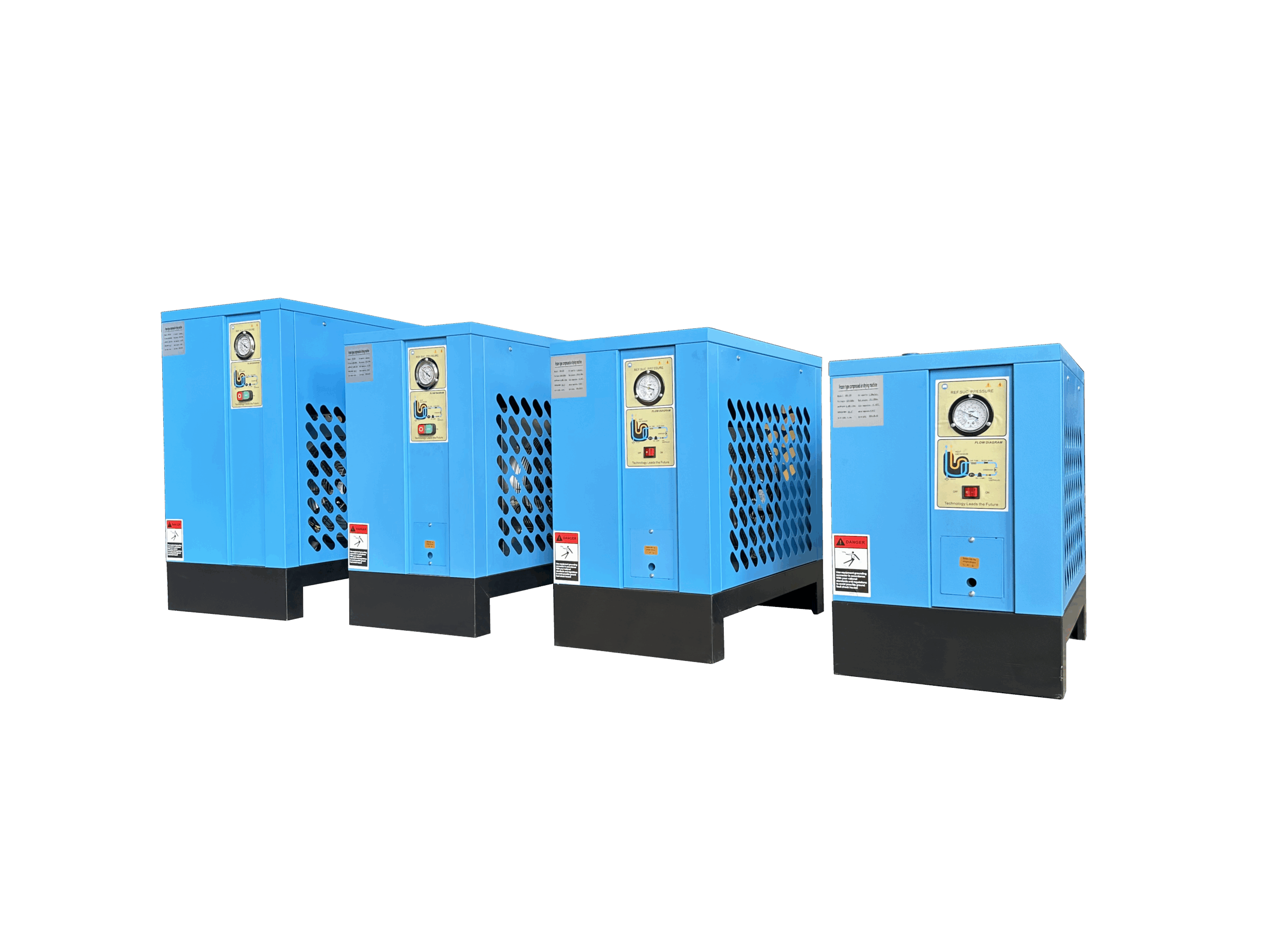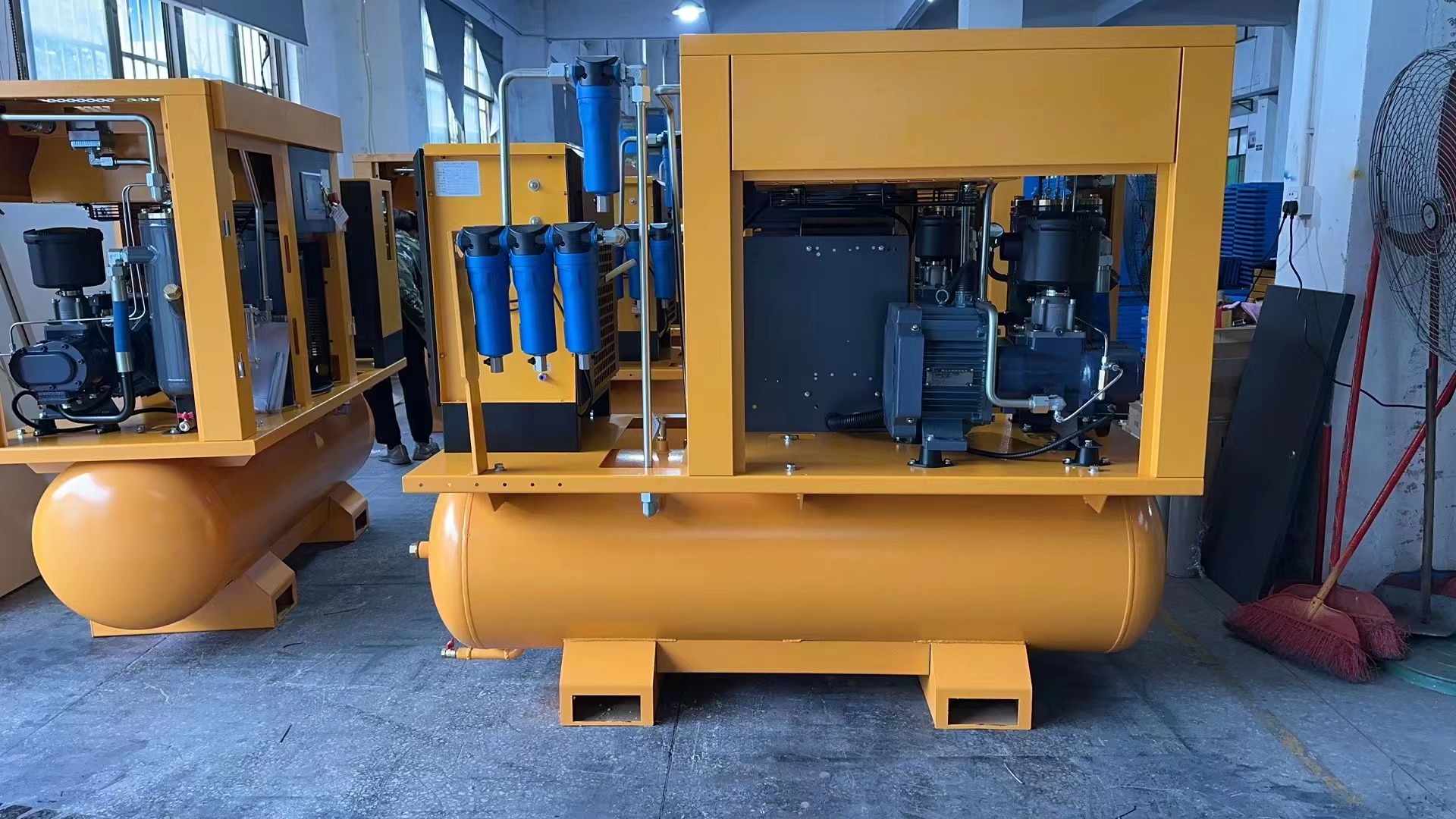Understanding Compressed Air and Dryers
Compressed air is created by taking in atmospheric air and compressing it to increase its pressure. This process powers a wide range of tools and machinery. Compressors come in different types, such as reciprocating and rotary screw models, each suited to specific needs.
Importance of Air Dryers in Compressed Air Systems
Air dryers are essential for removing moisture from compressed air. Moisture can condense within the system, leading to rust and other damage to your tools. An air dryer stops this by removing water vapor, ensuring smooth operation.
The types of air dryers include refrigerated, desiccant, and membrane dryers. Each type offers unique benefits, such as different levels of moisture removal and air quality enhancement.
Types of Air Compressors and Dryers

Identifying Various Air Compressors
Air compressors are machines that convert power into potential energy stored in pressurized air. Several types exist, but the most common ones are reciprocating, rotary screw, and centrifugal compressors.
- Reciprocating compressors use pistons to compress air and are cost-effective for small-scale applications.
- Rotary screw compressors feature two helical screws that rotate, offering a continuous flow and are suitable for industrial use.
- Centrifugal compressors use a rotating impeller to increase air pressure and are ideal for large-scale operations.
Exploring Air Dryers: Desiccant Vs. Refrigerated
Air dryers are crucial for removing moisture from air compressors. The two main types are refrigerated and desiccant dryers.
- Refrigerated air dryers cool the air to condense water vapor, an efficient choice for many industrial settings. They are reliable and require less maintenance.
- Desiccant dryers use a drying material to absorb moisture. These are perfect for situations needing ultra-dry air. They come in two styles: heatless and heated, with the latter offering better energy efficiency.
Other options include membrane air dryers, which use a selective membrane to remove water vapor, and deliquescent dryers, that dissolve a tablet or salt to dry air. Your choice will depend on the needed air quality, specific application, and environmental conditions where you operate.
Analyzing Air Dryer Specifications
When choosing an air dryer, you need to examine crucial specifications like dew point and air flow rates.
Dew Point and Its Significance
The dew point refers to the temperature at which air becomes saturated with moisture and condensation begins.
A dryer that offers a lower dew point will better protect your equipment from moisture-related issues.
Understanding Air Flow Rate and Operating Conditions
This ensures the dryer can handle the air volume efficiently without causing bottlenecks or shortages.
Operating conditions, like temperature and pressure, also play a role. Air dryers should match the requirements of your system’s conditions to work effectively. Consider how environmental variables might affect performance, and choose a dryer that is adaptable to these changes. Proper sizing in SCFM at desired pressure ensures the dryer will manage variations in your system smoothly.
Evaluating Air Quality Needs
When choosing an air compressor with a dryer, determining your air quality needs helps select the right equipment.
Assessing Air Quality Requirements
Air quality is crucial in determining the type of dryer you need. ISO 8573 is a standard that defines air quality requirements, including particle size and humidity levels. Look at this standard to see what suits your needs.
Particle size is an important factor. Smaller particles can harm sensitive equipment, so you may require a compressor that maintains low particle levels. Also, controlling humidity levels is crucial, as excess moisture can damage pneumatic systems.
For specific requirements, create a checklist of factors like required purity levels, acceptable humidity, and particle counts. Each parameter affects tool operation and product quality.
Applications: From Pneumatic Machinery to Food Processing

Different applications require varied air quality standards. In pneumatic machinery, ensuring air purity protects against rust and prolongs equipment life. Machines in this category often need air free of contaminants to operate efficiently and reliably.
In the food processing industry, the standards for air quality are even stricter. Compressors must provide clean, dry air to avoid any contamination. Food products are sensitive to air impurities, which can affect consumer health and product quality.
For compliance, consider using features such as advanced filtration systems. Filters help in capturing unwanted particles and managing humidity.
Selecting the Right Air Dryer for Your Needs
When selecting an air dryer for your compressed air system, it’s essential to understand two main aspects: key factors in choosing the right dryer and how ambient conditions and temperatures affect performance.
Considerations for Choosing the Appropriate Air Dryer
When choosing an air dryer, think about the quality of air required for your operations. Start by determining how dry the air needs to be. Consider the dew point specifications and required moisture content.
Compressor capacity should match the air dryer’s capabilities. If your air demand varies, a cycling dryer can help save energy by adjusting to load changes. In contrast, non-cycling dryers run continuously, providing a more consistent performance but potentially higher energy consumption.
Also, consider the types of dryers available: refrigerant dryers are good for moderate conditions, while desiccant dryers use absorbent materials for very dry air.
Impact of Ambient Conditions and Inlet Temperatures
Ambient conditions, such as temperature and humidity, can significantly impact the performance of your air dryer. High temperatures can reduce the efficiency of refrigeration dryers, while cooler temperatures might enhance their function. Knowing your environment’s typical conditions helps in selecting a dryer that performs best year-round.
The inlet air temperature at which your system operates also matters. Installing an aftercooler can help by lowering the temperature of compressed air before reaching the dryer, enhancing efficiency.
Frequently Asked Questions
What are the key features to look for when selecting an air dryer for a painting job?
For painting jobs, look for an air dryer that prevents moisture and contaminants. Consistent air pressure is critical for a smooth painting process. A dryer with good filtration ensures a high-quality finish.
How can I determine the correct size of air dryer needed for my air compressor?
Start by checking your compressor’s specifications. The air dryer must handle the maximum airflow rate (CFM) of your compressor. Consider the humidity and temperature for precise sizing.
Can you explain the benefits of using a refrigerated air dryer with an air compressor?
Refrigerated air dryers efficiently remove condensation. This prevents rust and reduces downtime. They are energy efficient and reliable, making them ideal for most routine applications.
What is the ‘rule of thumb’ for choosing the appropriate air compressor size?
Choose a compressor with a CFM rating 1.5 times the requirement of your highest-rated tool. This ensures efficient operation, while also allowing for multiple tools to be used simultaneously.
Where can I find a manual for maintaining an air compressor and its associated dryer?
Check the manufacturer’s website or contact their customer support. Many manuals are available online, providing step-by-step maintenance instructions for your equipment.
What considerations should I keep in mind when purchasing an air compressor with an integrated dryer?
Think about space, ease of maintenance, and cost. An integrated unit might save space but could be harder to service. Ensure it fits your workload and budget.
